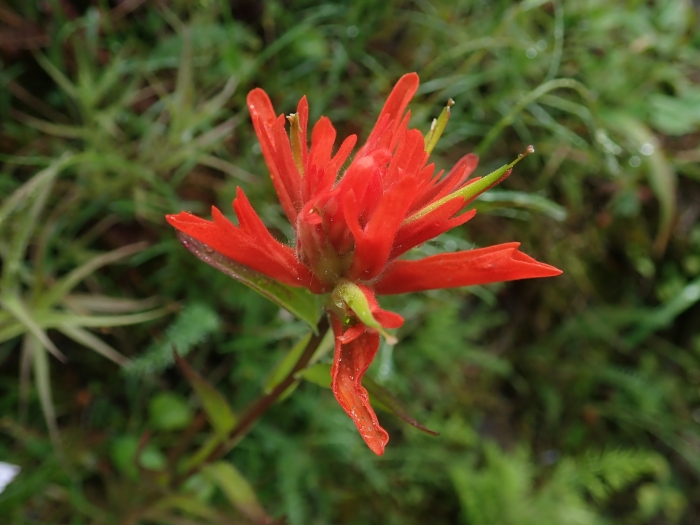Giant Red Indian Paintbrush
(Castilleja miniata)
Giant Red Indian Paintbrush (Castilleja miniata)
/
/

Randal
Public Domain
Image By:
Randal
Recorded By:
Copyright:
Public Domain
Copyright Notice:
Photo by: Randal | License Type: Public Domain | License URL: http://creativecommons.org/publicdomain/zero/1.0/ | Rights Holder: Randal | Publisher: iNaturalist | Date Created: 2020-07-09T10:16:34-07:00 |


























































Estimated Native Range
Summary
Castilleja miniata, commonly known as Giant Red Indian Paintbrush, is an herbaceous perennial native to moist meadows, grasslands, and open forests in the Western United States and Western Canada. It typically grows to about 80 centimeters tall with a slender form. The herbage can range from green to dark purple, and the lance-shaped leaves are 3 to 6 centimeters long, pointed, and coated in thin hairs. The inflorescence is striking, with bright red to pale orange or orange-tipped bracts that are often mistaken for flowers. The true flowers are yellow-green, red-edged, and tubular, blooming from May to September. The plant is particularly showy when in full bloom.
Giant Red Indian Paintbrush is valued for its vibrant color and ability to attract pollinators such as hummingbirds. It is used for naturalistic plantings and wildflower gardens. It requires full sun to part shade and prefers moist conditions, though it can tolerate a range of soil types as long as they have good drainage. While it is not typically grown in traditional garden settings due to its semi-parasitic nature, it can be used to enhance biodiversity in restoration projects. Care should be taken when planting as it may require a host plant to thrive.CC BY-SA 4.0
Giant Red Indian Paintbrush is valued for its vibrant color and ability to attract pollinators such as hummingbirds. It is used for naturalistic plantings and wildflower gardens. It requires full sun to part shade and prefers moist conditions, though it can tolerate a range of soil types as long as they have good drainage. While it is not typically grown in traditional garden settings due to its semi-parasitic nature, it can be used to enhance biodiversity in restoration projects. Care should be taken when planting as it may require a host plant to thrive.CC BY-SA 4.0
Plant Description
- Plant Type: Subshrub, Herb
- Height: 1-3 feet
- Width: 0.5-1.5 feet
- Growth Rate: Moderate
- Flower Color: Orange, Pink, Red
- Flowering Season: Summer
- Leaf Retention: Evergreen
Growth Requirements
- Sun: Full Sun, Part Shade
- Water: Medium
- Drainage: Fast
Common Uses
Bee Garden, Bird Garden, Butterfly Garden, Hummingbird Garden, Low Maintenance, Rabbit Resistant, Showy Flowers, Water Garden
Natural Habitat
Moist meadows, grasslands, and open forests
Other Names
Common Names:
Scientific Names: , Castilleja miniata, Castilleja hyetophila, Castilleja confusa, Castilleja inconstans, Euchroma integrifolia,
GBIF Accepted Name: Castilleja miniata Douglas